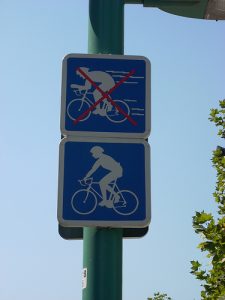Can a child ride on the pavement? Do I have to use cycle lanes where they’re available? And what on earth is meant by “cycling furiously”? The law around cycling in the UK is not particularly well understood by the general public, cyclists and non-cyclists alike, and a number of popular misconceptions still endure. Here’s a quick guide to some of the most relevant legislation.
Where can you ride a bike?
Bicycles are, in law, carriages, and should therefore be ridden on the carriageway (or, in common parlance, road) and not on the footway (pavement). The obvious exception to this is where designated cycle paths have been incorporated into the pavement. In these cases an approved cycle path sign permits the cyclist to use the footway for as long as that path continues.
Where no such cycle path exists cycling on the footway is an offence punishable by a fixed penalty notice of £50. This penalty cannot be applied to areas such as parks, or pedestrianised shopping precincts unless a byelaw has been passed making cycling in such areas an offence.
Government guidance suggests that penalties should not be aimed at responsible cyclists who sometimes feel obliged to use the pavement out of fear of traffic and should only be applied where a cyclist endangers others. In addition, fixed penalty notices cannot be applied to those under 16. A full discussion of the law in this regard can be found here.
It’s worth noting that, should you feel uncomfortable cycling on the road in a particular area, you can always dismount, walk with your bike, and then jump back on when clear of the problem. Alternatively, cycle training can increase your confidence and your understanding of how to ride in traffic.
Which parts of the road can I use?
According to the Highway Code cyclists are permitted to ride two-abreast, but should ride in single file on narrow or busy roads and when riding round bends. All rules for cyclists can be found here – note that those rules which omit the word “must” are advisory rather than compulsory.
It’s important to realise that cyclists are not restricted in law to riding in the part of the road next to the pavement. Confident cyclists take the middle of the lane (also known as primary position) whenever the situation dictates that this is appropriate.
Do I have to use cycle lanes?
Cyclists are not obliged to use cycle lanes, and discretion should be used as to when to use the available infrastructure. Some cycle lanes are poorly thought out or improperly integrated and should be avoided.
Cycling under the influence
It is an offence to cycle on a road when “unfit…through drink or drugs” according to Section 30 of the Road Traffic Act 1988. It is a misconception that you can get points on your driving licence for drunk cycling, but it goes without saying that endangering yourself and others by cycling whilst under the influence is to be avoided.
Cycling furiously
One of those quaintly worded offences that remains part of law is that of “wanton and furious driving”, applying to drivers of carriages (a bicycle, remember, counts as a carriage). Although rare, this offence may be applied where a cyclist injures another party as a result of wilful neglect or misconduct.
Jumping the lights
The rules of the road apply to cyclists just the same as motorists. Cyclists who contravene a traffic signal, which includes going through a red light, and cycling the wrong way on a one-way street, can be issued with a fixed penalty notice. Don’t do it.
What about the bike itself?
At the point of sale, a new bike must be equipped with (amongst other things) a bell, although as soon as it leaves the shop this can be discarded.
When riding in the dark a bike must be equipped with lights and reflectors, including two amber coloured reflectors on each pedal, which may well come as a surprise to those using clipless pedals. In practice of course this legislation is rarely enforced, although it is possible in the event of a nighttime collision that any failure to comply with the full lighting regulations may be regarded as contributory negligence.
NOTE: This post is for information and is not intended as legal advice.

Leave a Reply